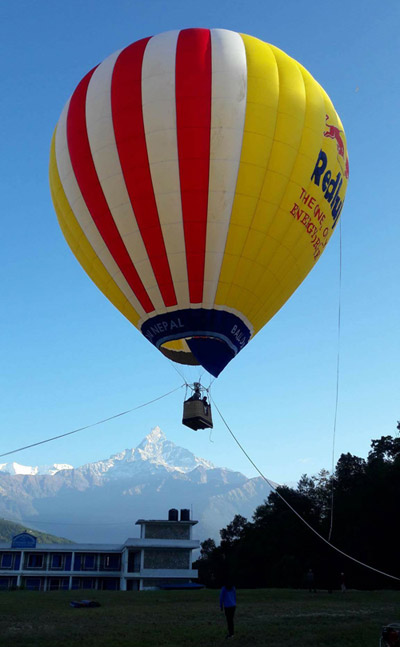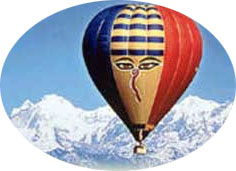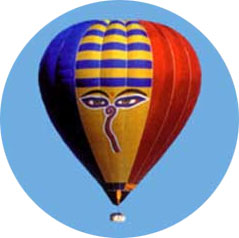Experience
the world's
Oldest but safest
Method of air travel to view the majestic Himalayas……
HISTORY OF BALLOONING
"Procure me some taffeta and
rope and I will astonish the world". This
statement was reportedly made by Joseph Montogolfier,
a French papermaker, (and his brother Etienne),
moore than 200 years ago. It was not as pompous
as it might seem. Watching smooke rise up the
chimmney, Joseph deduced that a paper bag filled
with hot air would rise hevenwards, too. The brothers
knew nothing of the relationship between pressure
density, temperature and the buoyancy of gases
and it was ten years before their experiments
convinced them to attempt a public demonstration.
On June 5, 1783, they did indeed
astonish the world with a linen balloon some 11
meters in diameter, infalted over a fire of damp
straw, old shoes and brandy-soaked rags. The Paris
Royal Academy of Science was impressed and on
September 19 that year, the Montgolfiers inflated
a balloon at Versailles before King Louise XVI
and Maries Antoinette. The passengers were a sheep,
a rooster and a duck and the flight lasted eight
minutes. Indecorously, the sheep trampled the
duck on landing, but the queen was so moved she
installed the world's first surviving aerial passengers
in her private zoo.
The historic first manned free flight followed
on November 21 when Jean Francois Pitatre De Rozier
and a nobleman, the Marquis D'Arlands, flew for
25 minutes at an average height of 300 ft. Their
balloon was not the simple functional design preferred
today. It was elaborately decorated with sighs
of zodiac worked in gold bearing an embellished
monogram of the King of France. The lower part
was garnished with masks, garlands and spread-eagles
and the circular basket festooned with draperies
and other ornaments. No wonder Marie Antoinett
dubbed ballooning the "Sport of the Gods",
thoughskeptics dismissed the bizarre activity
as a useless eccentricity of the aristocratic
classes. Others, however, saw great potential.
The American Benjamin Franklin was present at
the first launch and, when asked what useful purpose
the balloon might serve, replied: "Of what
use is a newborn baby?". Fortunately, many
shared his view.
ABOUT BALLOONING
IN NEPAL
On Balloon Sunrise Nepal's one hour
hot air balloon flight, this spectacular view
become unf orgettable.
Rise gently over the red-tile roofed houses, temples
and stupas and drift weightlessly over green terraced
fields in the crip morning air. Within minutes
of the ascent, the majestic Himalayan panorama
will greet you, from the rugged Langtang Himal
all the way to Mt. Everest.
orgettable.
Rise gently over the red-tile roofed houses, temples
and stupas and drift weightlessly over green terraced
fields in the crip morning air. Within minutes
of the ascent, the majestic Himalayan panorama
will greet you, from the rugged Langtang Himal
all the way to Mt. Everest.
Let moments freeze as you beyond
the pristine valley and drift along on board the
world's oldest but safest method of air travel.
One hour on the balloon will leave you with memories
to last a lifetime.
Flying 3000 m. above the Kathmandu
valley safely perched on a wicker basket, opens
up vast of enchanting sights accessible only to
the initiated. Breathe easily in the fresh, crisp
air of the quintessential Kathmandu dawn as you
absorb the 360 view of awe-inspiring landscape
- lush green hills, terraced fields enriched by
nature's colours, terra-cotta structures huddled
together like watchful sentinels, a gilded temple
spire, lonely stupa. Each one bathed by the first
golden rays of the rising sun.
Look right on and there before you
rises in majestic splendor the fabled. Himalayan
peaks. Illumined by stray strands of sunlight
the snow capped Gosainthan, Phurbi-Gyanchu, Guari-Shanker,
Chhoba-Bhamare, Melungste, Cho-Oyu, Chomolungma
and Gyanchungkang all stand to greet you and lull
you in to a dreamlike state, that will live on
as memories forever.
Where but in this Himalayan kingdom
of Nepal will you experience such breathtaking
sights at minimal costs and maximum safety. Ride
the winds with Balloon Sunrise Nepal and experience
the most mesmerizing sky ride over Kathmandu-the
moment that makes dreams a reality.
SCHEDULES
Daily flight, weather permitting,
from the first week of October through to the
end of April.
RATE
| Type |
Flight Duration |
Price |
Bird- Eye Flight
(Group Joining Flight) |
15 Minutes |
For Nepali: NRP 6000 Per Person
For Foreign: USD 90Per Person |
Eagle- Eye Flight
(Group Joining Flight) |
30 Minutes |
For Nepali: NRP 9000Per Person
For Foreign: USD 120Per Person |
Magical Voyage
((Group Joining Flight)) |
60 Minutes |
For Nepali: NRP 11000Per Person
For Foreign: USD 150Per Person |
Hot Air Romance
Hot Air Engagement
Hot Air Anniversary
Hot Air Birthday |
1 Hour |
For All Citizen:USD 250Per Person |
PASSENGER INFORMATION:
 AGE
: There is no age barrier to enjoying our
flights. However, a detree of fitness is required
as we may have to walk through paddocks after
landing. There are no seats in the basket - therefore,
standing for the duration of the flight ( about
on hour) is unavoidable.
AGE
: There is no age barrier to enjoying our
flights. However, a detree of fitness is required
as we may have to walk through paddocks after
landing. There are no seats in the basket - therefore,
standing for the duration of the flight ( about
on hour) is unavoidable.
We do not recommend bringing very
small children. The reason are twofold-the first
being the comfort and enjoyment oof the other
passengers. The baskets are quite small and young
children often get restless when in confined areas.
The second reason is more practical. The walls
of the baskets are four feet high, small children
would have difficulty in seeing over, unless carried
by an adult ( an arduous task for a one hour fight).
We do stipulate that children under 12 years must
be accompanied by an adult.
WHEN : We take off soon after
sunrise. Winds are usually at their calmest then.
Winter months provide the most reliable conditions.
We fly in the summer, but very early in the morning.
DURATION : Normally we fly
for about an hour, but this is at the pilot's
discretion, taking into account the winds, temperature
and weight carried on the day.
WHAT TO WEAR : Dress as for
hiking, including sturdy shoes or boots plus sun
glasses, gloves and a cap. It does not get any
colder in the balloon than on the ground.
PHOTOGRAPHY : Our advice
is to bring more film than you think you'll need.
There is so much to see, from an entirely new
perspective - you'll want to record it all to
relive later.
WHAT TO EXPECT
ON A PASSENGER FLIGHT ?
 Everyone meets at a predetermined
spot, usually half an hour before daybreak. After
a cup of tea and a short flight briefing theadventure
begins. At this time the wind direction is determined
and a launch site is chosen. Launch sites are
dotted around the valley, so that no matter where
the winds is coming from, the passengers are guaranteed
a lovely flight. The actual launch of the hot
air balloon usually takes place no more than half
an hour after arrival at the launch site. The
balloon and the basket are carried in a truck.
The basket is laid on its side and the gaily colored
fabric is pulled out of its bag. Flying wires
from the "Envelope" are attached, and
the whole system is given a "walk around"
inspection by pilot and Passengers may assist
with the inflation, or stand back and take photographs,
whichever they desire to do.
Everyone meets at a predetermined
spot, usually half an hour before daybreak. After
a cup of tea and a short flight briefing theadventure
begins. At this time the wind direction is determined
and a launch site is chosen. Launch sites are
dotted around the valley, so that no matter where
the winds is coming from, the passengers are guaranteed
a lovely flight. The actual launch of the hot
air balloon usually takes place no more than half
an hour after arrival at the launch site. The
balloon and the basket are carried in a truck.
The basket is laid on its side and the gaily colored
fabric is pulled out of its bag. Flying wires
from the "Envelope" are attached, and
the whole system is given a "walk around"
inspection by pilot and Passengers may assist
with the inflation, or stand back and take photographs,
whichever they desire to do.
Initially, a large fan is used to
direct cold air into the envelope - later the
burner is fired, thus heating the air already
in the balloon. As the warm air expands, the envelope
rises into position above the basket, ready for
flight..............a sleeping beauty brought
to life. As the balloon can only move in the same
direction as the wind is blowing and cannot return
to the launch site, it is necessary for the ground
crew to follow in a retrieve vehicle. Communication
beween the pilot and ground is maintained via
two - way radio. Flights are usually 45 minutes
to 1 hour in duration. At the final landing point,
the retrieve erew assist in packing up the envelope
and basket. A flight certificate and souvenir
pack are distributed to all passengers, rounding
off a fabulous adventure. From the start ti finish
the ballon adventure takes about 5 hours, yet
the experience will leave you with warm memories
which will last a lifetime.
HOT - AIR BALLOONING
IN KATHMANDU- THE FACTS
- WHAT IS IT MADE OF ? Rip-stop
nylon, just like parachutes, or the spinnaker
on a sailboat. The material is treated with
polyurethane to stop porosity and contain the
hot air. The basket is traditioal wicker, like
the laundry baskets of days gone by.
- HOW LONG CAN IT STAY IN THE
AIR ? Normally about 2 to 4 hours.
depending upon the ambient (outside) air temperature,
and the weight that is carried. Oon a cold day
with only one person flying, a 4 hours flight
would not be uncommon.
- HOW FAST CAN IT GO
? As fast as the wind blows. For student
pilots it is safer flying in winds up too 8
knots; 15 knot winds are the limit. High wind
landings require skill and experience.
- HOW DO YOU HEAT THE AIR ?
L P GAS, the same as most people use in
their homes. The hot air causes the balloon
to rise, then as it cools, it will descend.
- HOW MANY PEOPLE DOES IT TAKE
IFLATE A BALLOON ? A minimum of three, ubt
preferable five, particulary if the - wind of
over 8 knots.
- HOW LONG DOES IT TAKE TO INFLATE,
DEFLATE AND PACK ? Each operation takes
approximately 25 minutes, if all goes well.
- WHICH INSTRUMENTS DOES A BALLOON
USE ? An altimeter to indicate altitude,
a variometer showing whether the balloon is
climbing or descending, a compass to show direction
a themister which records the temperature in
the crown, or top, of the balloon and a Global
Position System for navigation. each propane
tank has a fuel gauge.
- DO BALLOONISTS CARRY PARACHUTES
? Not, ususally. If the burner goes out
and for some reason cannot be reignited, the
balloon acts a parachute and descends at parachute
speed.
- WHEN DO YOU FLY ? Usually
soon after sunrise or just before dusk. Winds
are generally calm then. Winter months provide
safe and pleasant condition for ballooning.
Summer heat brings thermal activity which can
be extremely dangerous.
- HOW MANY PEOPLE CAN FIT IN
A BASKET ? It depends on the size of the
balloon, but usually it varies from 2 in sport
balloons, up to 8 people in passenger balloons.
- CAN YOU STEER A BALLOON ?
Generally speaking, no you do not. It goes where
the wind goes. It is possible to choose an altitude
where the wind direction is the one which is
needed.
- HOW DO YOU RETURN TO THE LAUNCH
SITE ? The balloon crew track the flight
and are usually there when the balloon lands.
After packing all away on the trailer or in
the retrieve vehicle, everyone heads for refreshments
Note:
For the movement this trip is not in operation.
We are sorry for your inconvinience.